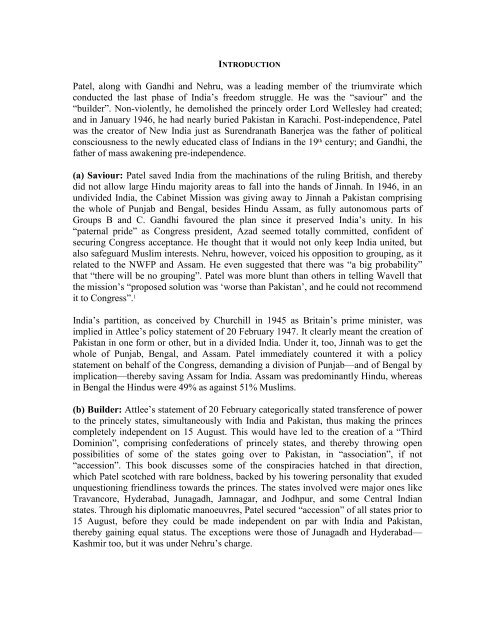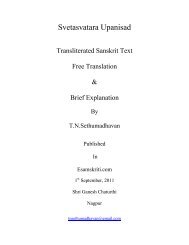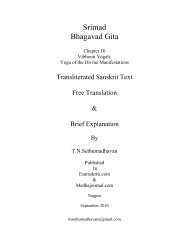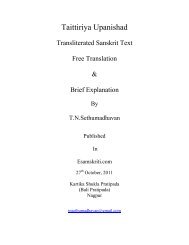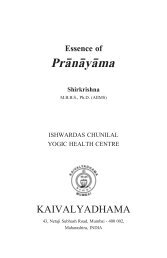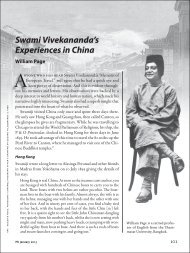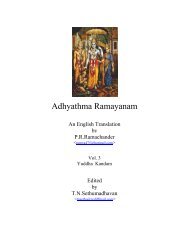SARDAR VALLABHBHAI PATEL Balraj Krishna - Esamskriti.com
SARDAR VALLABHBHAI PATEL Balraj Krishna - Esamskriti.com
SARDAR VALLABHBHAI PATEL Balraj Krishna - Esamskriti.com
- No tags were found...
Create successful ePaper yourself
Turn your PDF publications into a flip-book with our unique Google optimized e-Paper software.
INTRODUCTIONPatel, along with Gandhi and Nehru, was a leading member of the triumvirate whichconducted the last phase of India’s freedom struggle. He was the “saviour” and the“builder”. Non-violently, he demolished the princely order Lord Wellesley had created;and in January 1946, he had nearly buried Pakistan in Karachi. Post-independence, Patelwas the creator of New India just as Surendranath Banerjea was the father of politicalconsciousness to the newly educated class of Indians in the 19 th century; and Gandhi, thefather of mass awakening pre-independence.(a) Saviour: Patel saved India from the machinations of the ruling British, and therebydid not allow large Hindu majority areas to fall into the hands of Jinnah. In 1946, in anundivided India, the Cabinet Mission was giving away to Jinnah a Pakistan <strong>com</strong>prisingthe whole of Punjab and Bengal, besides Hindu Assam, as fully autonomous parts ofGroups B and C. Gandhi favoured the plan since it preserved India’s unity. In his“paternal pride” as Congress president, Azad seemed totally <strong>com</strong>mitted, confident ofsecuring Congress acceptance. He thought that it would not only keep India united, butalso safeguard Muslim interests. Nehru, however, voiced his opposition to grouping, as itrelated to the NWFP and Assam. He even suggested that there was “a big probability”that “there will be no grouping”. Patel was more blunt than others in telling Wavell thatthe mission’s “proposed solution was ‘worse than Pakistan’, and he could not re<strong>com</strong>mendit to Congress”. 1India’s partition, as conceived by Churchill in 1945 as Britain’s prime minister, wasimplied in Attlee’s policy statement of 20 February 1947. It clearly meant the creation ofPakistan in one form or other, but in a divided India. Under it, too, Jinnah was to get thewhole of Punjab, Bengal, and Assam. Patel immediately countered it with a policystatement on behalf of the Congress, demanding a division of Punjab—and of Bengal byimplication—thereby saving Assam for India. Assam was predominantly Hindu, whereasin Bengal the Hindus were 49% as against 51% Muslims.(b) Builder: Attlee’s statement of 20 February categorically stated transference of powerto the princely states, simultaneously with India and Pakistan, thus making the princes<strong>com</strong>pletely independent on 15 August. This would have led to the creation of a “ThirdDominion”, <strong>com</strong>prising confederations of princely states, and thereby throwing openpossibilities of some of the states going over to Pakistan, in “association”, if not“accession”. This book discusses some of the conspiracies hatched in that direction,which Patel scotched with rare boldness, backed by his towering personality that exudedunquestioning friendliness towards the princes. The states involved were major ones likeTravancore, Hyderabad, Junagadh, Jamnagar, and Jodhpur, and some Central Indianstates. Through his diplomatic manoeuvres, Patel secured “accession” of all states prior to15 August, before they could be made independent on par with India and Pakistan,thereby gaining equal status. The exceptions were those of Junagadh and Hyderabad—Kashmir too, but it was under Nehru’s charge.


